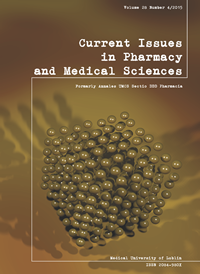A brief analysis of patients suffering from stomach or duodenal ulcers in Almaty hospital №1
DOI:
https://doi.org/10.1515/cipms-2015-0079Keywords:
stomach ulcer, duodenal ulcer, hospitalAbstract
Peptic ulcers are a serious problem worldwide, and affect about 4 million people each year. Their etiology is connected with the presence of Helicobacter pylori, the act of smoking, drinking alcohol, being stress, and taking excessively nonsteroidal anti-inflammatory drugs, as well as steroids. The most common symptoms are abdominal pain, nausea, chest pain and fatigue, while less frequent symptoms include vomiting and weight loss. Helicobacter pylori is responsible for about 80% of gastric and 90% of duodenal ulcer cases. In this work, an analysis is made of a correlation between stomach or duodenal ulcer and gender, residence and number of patients hospitalized in the Almaty hospital №1, from 2009-2012, in order to learn about trends in the incidence of these diseases in Kazakhstan. A total number of 950 patients with stomach and duodenal ulcers, in 2009-2012, were questioned. The patient’s residence, gender and stomach or duodenal ulcer problem were taken into account in the study. The result of this work reveals that the largest amount of hospitalized patients suffering from stomach or duodenal ulcers came from urban areas. Moreover, more women than men suffered from peptic ulcers. Furthermore, the number of patients admitted to the hospital due to duodenal ulcers did not show any variation throughout the study. However, the least number of patients suffering from gastric ulcers was noticed in December 2009, and the greatest was in October and November 2011. The obtained data show that ulcers are a serious problem in Kazakhstan.
References
1. Bodhidatta, L., et al.: Diagnosis of Helicobacter pylori infection in a developing country: comparison of two ELISA and a seroprevalence study. J. Infect. Dis., 168, 1551, 1993.
2. Brown L. M.: Helicobacter pylori: epidemiology and routes of transmission. Epidemiol. Rev., 2, 290, 2000.
3. Bruce M. G., et al.: Alaska sentinel surveillance for antimicrobial resistance in Helicobacter pylori isolates from Alaska native persons, 1999-2003. Helicobacter,11, 583, 2006.
4. Cai S., et al: Uncomplicated peptic ulcer in the UK: trends from 1997 to 2005. Aliment. Pharm. Therap., 30, 1041, 2009.
5. Cotticelli L., et al.: Central serous chorioretinopathy and Helicobacter pylori. Eur. J. Ophthalmol., 16, 276, 2006.
6. Giusti C.: Association of Helicobacter pylori with central serous chorioretinopathy: Hypotheses regarding pathogenesis. Med. Hypotheses, 63, 525, 2004.
7. Hoang T. T. H., et al.: Sero-prevalance of Helicobacter pylori infection in urban and rural Vietnam. Clin. Diagn. Lab. Immun., 12, 83, 2005.
8. Hunt R. H., et al.: Helicobacter pylori in developing countries. http://www.worldgastroenterology.org/assets/downloads/en/pdf/guidelines/11_helicobacter_pylori_developing_countries_en.pdf (cited: 13.03.2015 11:19)
9. Kazachstan in figures 2011, Astana 2012 http://www.ecosn.org/Portals/0/Publications/Kazakhstan/Kazakhstan%20in%20figures%202011.pdf (cited: 24.03.2015 13:27).
10. Lau J. Y., et al.: Systematic review of the epidemiology of complicated peptic ulcer disease: incidence, recurrence, risk factors and mortality. Digestion, 84:105, 2011.
11. Marshall B.J. and Warren J. R.: The bacterium Helicobacter pylori and its role in gastritis and peptic ulcer disease. http://www.nobelprize.org/nobel_prizes/medicine/laureates/2005/press.html (cited: 13.03.2015 10:23).
12. MedlinePlus http://www.nlm.nih.gov/medlineplus/ency/article/000206.htm (cited: 27.03.2015).
13. Prabhu V. and Shivani A: An overview of history, pathogenesis and treatment of perforated peptic ulcer disease with evaluation of prognostic scoring in adults. Ann. Med. Health Sci. Res., 4, 25, 2014.
14. Romero-Gallo J., et al.: Responses of endoscopy patient in Ladakh, India, to Helicobacter pylori whole-cell and CagA antigens. Clin. Diagn. Lab. Immunol., 9, 1315, 2002.
15. Schubert T. T, et al.: Ulcer risk factors: Interactions between Helicobacter pylori infection, nonsteroidal use, and age. Am. J. Med., 94, 416, 1993.
16. Thorsen K., et al.: Epidemiology of perforated peptic ulcer: Ageand gender-adjusted analysis of incidence and mortality. World J. Gastroenterol., 19, 349, 2013.
17. Youn H. S., et al.: Comparison of Helicobacter pylori infection between Fukuoka, Japan and Chinju, Korea. Helicobacter, 3, 11, 1998.
18. Zelickson M. S., et al.: Helicobacter pylori is not the predominant etiology for peptic ulcers requiring operation. Am. Surg., 77, 1059, 2011.
Downloads
Published
Issue
Section
License
Copyright (c) 2015 Authors

This work is licensed under a Creative Commons Attribution-NonCommercial-NoDerivatives 3.0 Unported License.


